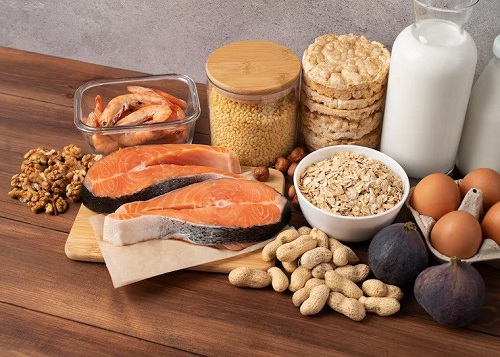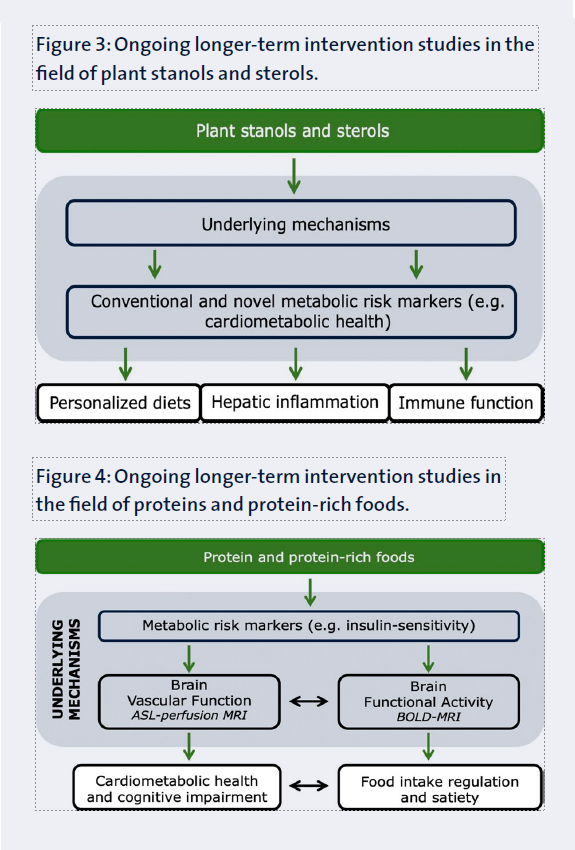Advancing Nutrition Research with novel technologies and innovative approaches
Division 1: Obesity, Diabetes & Cardiovascular Health Department of Nutrition and Movement Sciences
Background
Modern nutrition research
Nutrition research has changed over the past decades. We have therefore enriched our research portfolio from intervention studies focusing on the preventative impact of single nutrients on metabolic health parameters towards studies evaluating effects of nutrients, whole foods and dietary patterns in healthy individuals. Moreover, primary outcome parameters are not only plasma biomarker profiles, but also a wide array of non-invasive in vivo functional markers for specific tissues. These novel “functional” markers may be even more important predictors for the development of non-communicable diseases and offer promising opportunities for evidence-based prevention strategies.
Our research group is internationally well-recognized for their contributions to the complete spectrum of research approaches (nutrients - whole foods - dietary patterns). We apply innovative technologies (such as vascular parameters in periphery and brain, fundus analysis, markers for cholesterol absorption and synthesis, wearables for continuous metabolic monitoring in home settings, clamp techniques, magnetic resonance imaging (MRI)), focusing on functional endpoints (cardio metabolic health, satiety, weight-loss maintenance strategies, and cognition). In our studies, we generate in particular novel “fundamental” data for a certain nutrient / food (pattern). The major aim is to translate that findings ultimately to dietary guidelines and can be used to extend already proven health benefits towards novel areas.
Major breakthroughs
Example 1: Plant sterol and plant stanols
Plant sterols - and their saturated derivative the plant stanols - resemble the molecular structure of the mammalian cholesterol. These plant substances lower the atherogenic LDL-cholesterol concentrations by reducing intestinal cholesterol absorption. These conclusions are based on many studies to which we have contributed substantially. In fact, in the late 90’s we were the first group outside Finland to demonstrate the cholesterol-lowering efficacy of plant stanols.
This study was the first of many studies addressing effects of consumption frequency, impact of food matrix, mechanistic aspects, and the combined intake with statins and fibres on the LDL-cholesterol lowing effects of these plant-derived functional ingredients. In later studies, we also showed that plant stanols lowered serum riacylglycerol concentrations in subjects with overt hypertriglyceridemia.
Who is involved?
Dr. Tanja C. M. Adam, Dr. Sabine Baumgartner, Dr. Peter J. Joris, Prof. Dr. Ronald P. Mensink, Prof. Dr. Jogchum Plat, Dr. Herman E. Popeijus.
The research is embedded with the PHuN (Physiology of Human Nutrition) group from the Department of Nutrition and Movement Sciences.
Except for the staff members, also PhD-students from both the Netherlands and abroad and supporting personnel are an essential part of our research group.
More recently, additional benefits beyond those on the serum lipoprotein are explored, i.e., effects on immune function and (liver) inflammation. For immune function, we have first shown that plant sterols and stanols can normalize a possible disbalance between the activity of T-helper 1 and T-helper 2 cells in vitro via activation of regulatory T-cells via TLR2 activation. Findings were confirmed in a randomized placebo-controlled human intervention trial with allergic asthma patients, in which Th2 cells are overactive. Plant stanol consumption dampened this Th2-activity by activating the Th1 response as shown by boosting the vaccination response to Hepatitis A. Interestingly, this effect was particularly evident in subject with a higher BMI, who clearly have a compromised immune response (Figure 1).
Our recent studies also showed that in LDL-receptor knockout mice plant sterols and stanols inhibited liver inflammation, as induced by a high-fat, high- cholesterol diet (collaboration with Prof. R. Shiri-Sverdlov, division 2). This was shown by lower CD68 staining and a lower number of Kupffer cells, as well as decreased gene expression of inflammatory cytokines TNFα, IL-1β, and MCP-1. Hepatic steatosis did not change.

Example 2: Protein-rich foods and diets
Considering the well-established effect of proteins on satiety, diet-induced thermogenesis and the preservation of fat-free mass during weight loss, proteins are the intuitive nutritional component of a whole food-based intervention for intentional weight loss and weight-loss maintenance. These effects may in part be mediated through an effect on food reward signalling in the brain. In our studies assessing whole food high protein intake we found an inverse relationship with high protein intake and brain reward activity, and a positive association between high protein intake and changes in body weight. The results pose a potential mechanistic link between protein intake and weight maintenance after weight loss (Figure 2). Furthermore, we could establish that this relationship was mediated by changes in insulin sensitivity.
For longer-term intake of soy nuts, which are not only rich in proteins but also in other potential bioactive ingredients, we observed in older subjects an increased regional cerebral blood flow (CBF), a physiological marker of cerebrovascular function. Psychomotor speed was also improved. In addition, non-invasive markers of the peripheral vasculature changed in a positive way. These effects may be important mechanisms by which protein intake reduces cardiometabolic risk and cognitive decline.
Scientific impact/Research quality
Our studies with plant sterol and stanol esters (Example 1) have contributed to the positioning of products enriched with these nutrients in some (international) dietary guidelines. Moreover, our so-called frequency study demonstrating that a single intake of plant stanols was as effective as the same intake divided over three meals was the basis for the development of the highly successful commercially available one-shot yoghurt mini-drinks. Regarding the studies focusing on the longer-term effects of protein-rich foods and diets
(Example 2), findings extended the evidence that these foods and diets prevent age-related health conditions, such as cardiovascular disease and cognitive impairment, due to their beneficial effects on vascular function and metabolic health; not only in the periphery, but also the brain.
Users and collaborations
In our research projects, we collaborate with various national and international user and research groups, and industrial partners (ranging from SME to multinational) and receive funding from ZonMw, NWO, TKI-LSH, TTW, several product-related foundations and the EU.
Future Perspectives
For plant sterols and stanols (Figure 3), we are currently examining whether (i) we can make the advice to use plant sterol or stanol-enriched products more personalized, based on genetic profiling (ii) plant sterols and stanols lower hepatic inflammation and (iii) the dampening effect of plant stanol consumption on the Th2 response also translates into less symptoms in a large multi-centre clinical trial in patients with allergic asthma.
For protein and protein-rich foods (Figure 4), the existing knowledge describing effects on (functional) markers in the periphery will be further corroborated with innovative markers in the brain. Ongoing trials focus on effects of whole foods (almonds, mixed nuts) and protein hydrolysates.
Innovative non-invasive brain MRI methods are used to investigate brain vascular function and insulin-sensitivity, and functional activation of brain reward areas in response to visual stimuli. For this, MRI scanner facilities and support at the Scannexus are used. Specific focus is on functional outcomes such as cognitive performance and food intake.
Selection of publications
- Baumgartner S, Ras RT, Trautwein EA, Mensink RP, Plat J Plasma fat-soluble vitamin and carotenoid concentrations after plant sterol and plant stanol consumption: a meta-analysis of randomized controlled trials. Eur J Nutr 2017; 56:909-923.
- Brüll F, De Smet E, Mensink RP, Vreugdenhil A, Kerksiek A, Lütjohann D, Wesseling G, Plat J. Dietary plant stanol ester consumption improves immune function in asthma patients: results of a randomized, double-blind clinical trial. Am J Clin Nutr 2016; 103:444-453.
- Drummen M, Heinecke A, Dorenbos E, Vreugdenhil A, Raben A, Westerterp-Plantenga MS, Adam TC. Reductions in body weight and insulin resistance are not associated with changes in grey matter volume or cortical thickness during the PREVIEW study. J Neurol Sci 2019; 403:106-111.
- Drummen M, Dorenbos E, Vreugdenhil AC, Raben A, Westerterp-Plantenga MS, Adam TC. Insulin resistance, weight and behavioral variables as determinants of brain reactivity to food cues - a PREVIEW Study. Am J Clin Nutr 2019; 109:315-321.
- Joris PJ, Plat J, Kusters YH, Houben AJ, Stehouwer CD, Schalkwijk CG, Mensink RP. Diet-induced weight loss improves not only cardiometabolic risk markers, but also markers of vascular function: A randomized controlled trial in abdominally obese men. Am J Clin Nutr 2017; 105:23-31.
- Kleinloog JPD, Mensink RP, Ivanov D, Adam JJ, Uludağ K, Joris PJ. Aerobic exercise training improves cerebral blood flow and executive function: a randomized, controlled cross-over trial in sedentary older men. Front n Aging Neurosci 2019; 11:333.
- Mensink RP, de Jong A, Lütjohann D, Haenen GR, Plat J. Plant stanols dose-dependently decrease LDL-cholesterol concentrations, but not cholesterol-standardized fat-soluble antioxidant concentrations, at intakes up to 9 g/d. Am J Clin Nutr 2010; 92:24-33.
- Plat J, Baumgartner S, Vanmierlo T, Lütjohann D, Calkins KL, Burrin DG, Guthrie G, Thijs C, Te Velde AA, Vreugdenhil ACE, Sverdlov R, Garssen J, Wouters K, Trautwein EA, Wolfs TG, van Gorp C, Mulder MT, Riksen NP, Groen AK, Mensink RP. Plant-based sterols and stanols in health & disease: Consequences of human development in a plant-based environment? Prog Lipid Res 2019; 74:87-102.
- Talbot CPJ, Plat J, Ritsch A, Mensink RP. Determinants of cholesterol efflux capacity in humans. Prog Lipid Res 2018; 69:21-32.
- Tayyeb JZ, Popeijus HE, Mensink RP, Konings MCJM, Mokhtar FBA, Plat J. Short-chain fatty acids (except hexanoic acid) lower NF-kB transactivation, which rescues inflammationinduced decreased apolipoprotein A-I transcription in HepG2 cells. Int J Mol Sci 2020; 21:5088.



